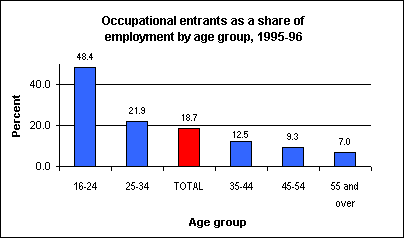An official website of the United States government
 United States Department of Labor
United States Department of Labor
In February 1996, almost one of every five workers had entered a new occupation within the past year. Young workers were most likely to be occupational entrants; about 48 percent of all workers aged 16 to 24 were new to their occupations.

[Chart data—TXT]
The percentages of workers entering a new occupation declines with age. Although workers aged 35 to 44 had the largest employment by age group, only 12.5 percent of those workers had entered a new occupation in the previous year. The proportion fell to 9.3 percent for workers aged 45-54, and 7.0 percent for workers aged 55 and over.
Younger workers have higher occupational entry rates for several reasons. Many young workers enter their first job after completing school; 45 percent of young entrants were not working the previous year. Additionally, young workers often try out several occupations before settling on a career.
These data are a product of the Current Population Survey. Additional information is available from "Occupational Entrants in 1995-96", Occupational Outlook Quarterly, Winter 1998-99.
Bureau of Labor Statistics, U.S. Department of Labor, The Economics Daily, Young workers more likely to try new occupations at https://www.bls.gov/opub/ted/1998/dec/wk3/art01.htm (visited May 18, 2024).

